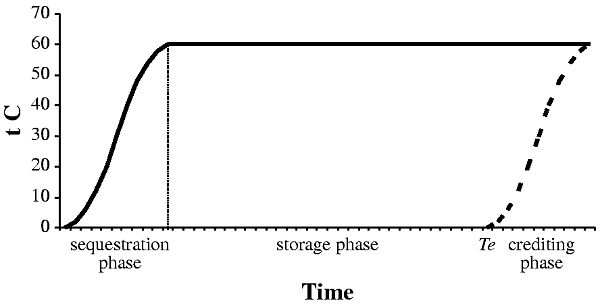5.4.2.1.3. Alternative approaches
Alternative approaches have been proposed to better address the temporal dimension
of carbon storage. Most of these approaches are based on adopting a two-dimensional
measurement unit that reflects storage and time-namely, the ton-year. Many authors
have proposed the concept of a ton-year unit (Moura-Costa, 1996a,b; Fearnside,
1997; Greenhouse Challenge Office, 1997; Chomitz, 1998; Dobes et al.,
1998; Tipper and de Jong, 1998; Fearnside et al., 2000; Moura-Costa and
Wilson, 2000). The general concept of the ton-year approach is in the application
of a factor to convert the climatic effect of temporal carbon storage to an
equivalent amount of avoided emissions (the remainder of this section refers
to this factor as the equivalence factor, or Ef ); this factor varies from 0.007
to 0.02 (Dobes et al., 1998; Tipper and de Jong, 1998; Moura-Costa and
Wilson, 2000). This factor is derived from the "equivalence time" concept (referred
to as Te in the remainder of this section): the length of time that CO2 must
be stored as carbon in biomass or soil to prevent the cumulative radiative forcing
effect exerted by a similar amount of CO2 during its residence in the atmosphere
(Moura-Costa and Wilson, 2000). Chapter 2 describes the
theory and methods used for determining Ef.

|
|
Figure 5-4: Projection of carbon stored in
an afforestation project (with baseline assumed to be zero), illustrating
the concept of equivalence-factor yearly crediting (ton-years).
The project receives yearly credits calculated as the total amount of
carbon stored in any given year, multiplied by an equivalence factor,
Ef. Alternatively (in the case of stock change crediting with ton-year
liability adjustment), credits could be given as carbon is stored
(solid line); in case of any event leading to the release of carbon
stored, the amount of credits to be returned would be calculated as
the difference between the solid line and the dotted line at that point
in time.
|
Irrespective of the method used to calculate the equivalence factors, they
could be useful for the accounting of GHG benefits of LULUCF projects. Different
applications have been proposed (Moura-Costa and Wilson, 2000); in practice,
a combination of approaches can be used, as follows:
- Equivalence-adjusted average storage, using Te as the denominator
of the average storage equation. This method could be used to standardize
the way in which the average storage method is currently used.
- Stock change crediting with ton-year liability adjustment, giving
projects credits according to the stock change method but using ton-years
to calculate the amount of credits to be removed in the case of any noncompliance
(in the case of occurrence of risk-related events).
- Equivalence-factor yearly crediting (ton-years), by which a project
is credited yearly with a fraction of its total GHG benefit; this fraction
is determined by the amount of carbon stored each year, converted using Ef
(Figure 5-4). This approach would greatly discourage
the implementation of LULUCF projects.
- Equivalence-delayed full crediting, recognizing the full benefits
of carbon sequestration only after storage for a time period Te (Figure
5-5). This delayed crediting likely would discourage the implementation
of LULUCF projects.
- Ex-ante ton-year crediting, giving projects an amount of credits
at the beginning of the project, according to the planned project duration,
using the ton-year approach. This approach would reduce the disadvantages
that delayed crediting would create for project developers.

|
|
Figure 5-5: Projection of carbon stored in
an afforestation project (with baseline assumed to be zero), illustrating
the concept of equivalence-delayed full crediting. In this example,
the project receives credits only after planted trees have grown and
been kept for a period of time, Te.
|
(continues on next page)
|